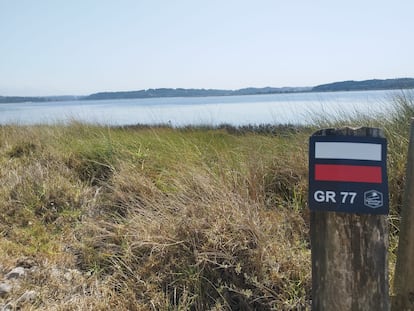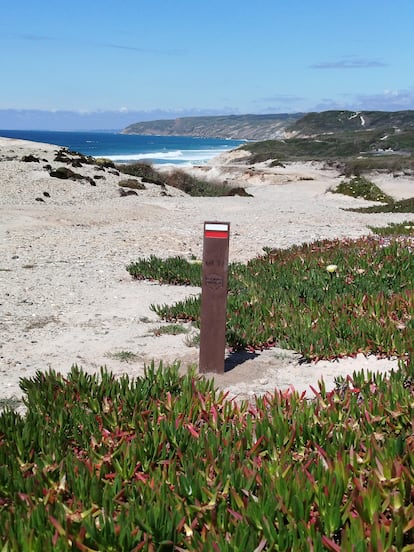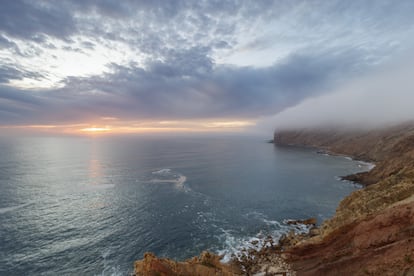The road never advances alone. He is accompanied by the ocean, always there to the side, inseparable. It doesn’t even need to turn the head: the path parades between breeze, salt smell and the noise of the broken waves. An immense blue horizon watches every step, from the left. On the right, bushes, houses and earth dye the route of green, white and red. It is necessary to deviate a little to find another presence, less evident, although no less colossal: dinosaur imprints rest, which also walked here millions of years ago. And at the end of the tour, one hour and a half later, they await two more quotes: with the perfect sand and sea shell that draws the Bay of San Martinho do Porto, on the central coast of Portugal; and with the remains of a port where ships were built that Vasco da Gama set for the Indies. Or so the legend says. The truth is that the view takes away your breath.
For these lands, in a few weeks, another ambitious trip starts. The inauguration of the first sections of Palmilhar Portugal, which aims to be the longest circular path in the world: about 6,000 kilometers between mountains and beaches, forests and vineyards, villages and lagoons is scheduled. The country toured for three days – and with the collaboration of the organization – the initial steps of a path that promises, from here to five years, to agree with tourists and who hate them: a sustainable and authentic route, for any person and month of the year. From the interior to the coast, and vice versa, in search of exploration, discovery, nature, culture and history. Although the word perhaps more repeated by Ricardo Bernardes, promoter of the project, is “interaction.” With the territory and, above all, its people.
“In addition to ‘Ooooh, what a landscape’, I would like visitors to think ‘Ooooh, what contact.’ If this manages to give some life to the less transitted areas it will make me happy,” he defines. He does not want hurry, nor a list of destinations to fill the race. On the contrary, imagine encounters that arise around each corner. First of all, with the locals, always willing to give at least one “bom day“To the stranger; but also with festivals, concerts, exhibitions, guided tours and other cultural activities that must sprout through the itinerary, according to Bernardes. The essence of Palmilha that cross steps with some hiker.
Bernardes is convinced that the 14th most visited country in the world – in data from the World Tourism Organization – hides many jewels like that, far from its most famous cities and localities. “We are a small nation, but in just 150 kilometers you can find completely different scenarios and enormous cultural diversity,” he emphasizes. As spectacular sandy sand in the middle of August; about 370 original meters of Roman road, from the 1st century, near Alqueidão da Serra; or a atelier Dedicated to the most unexpected crafts: desserts. In a couple of days the Route Scale Colinas and Brza Bañistas, crosses rivers or local fairs. Showing variety, and unusual alliances. As a capital sin converted into art by the Monks of Alcobaça, celebrated by Passera Teachers; or a demolished monastery overlooking hectares of vineyards: namely Nossa Senhora would say. O novels and vegetables for sale together, in a bookstore of the medieval town of Obids. “Leave only imprints; collect experiences; take memories,” says a tourist brochure of this municipality.

To fill visitors with memories, Bernardes works in full pace towards the future. Although, right now, Palmilhar Portugal also requires resistance and imagination. The first is presupposed to any mountaineer. And to any project of this magnitude. The creative look, on the other hand, serves to fill the distance that still separates the first step from the horizon: for the moment, the plan has six adhered municipalities (such as Alcobaça, Alenquer or Obidos) of the 100 that he hopes to add; It will have a mobile application with a real -time map and notifications on the closest points and events of interest, but we will have to wait for the beginning of 2026; and the signs they have made with sustainable materials are installed only in some sections. In the Obid Lagoon, a child starts a family game of Petanca by throwing the bolillo. The Bernardes project is also launched. Now it is about continuing to throw news with success. Although the driver seems to be clear about the way.
Every time he to explain: “The path will pass through here, and then there.” He has raised the entire initiative with a personal investment; He wants only public land and municipalities only contribute an initial fee, to start the paths of each area. From there, its business model provides small commissions for hotels, restaurants or any other establishment that wants to participate, and cultural events and activities as the main source of income. Bernardes recognizes risks and difficulties, but refuses the shortcuts. Faced with the suggestions of baptizing his project in English, he chose a synonym for “walking” in Portuguese. And among the few famous places that Palmilhar Baraja play is the Sanctuary of Fatima, a few kilometers from here. Perhaps, in return, the Virgin throws her blessed hand. Marathon runners have already contacted Bernardes to be the first to make the entire route, when it is. He is glad, but claims a more leisurely rhythm: “Little by little.”

The same one who wants to print to the path. Only who will pass slowly on some walls of the monastery of Santa María de Alcobaça, Unesco World Heritage: the workers of the twelfth century were paid per piece in place of hours, hence will sign About the material. The other side of the building, converted into a five -star hotel by the architect Pritzker Souto Moura award, reinforces the message: even the luxury of the service is provided with minimalism and idle. It also takes a while to see birds in the Obid Lagoon or discover that a restaurant in La Aldea, Literary Man, serves dishes inspired by famous books and comics. A pique on who produces the best ginjathe local liquor; Cheese delights for sale in a store without claim, inside a gas station; A church upholstered with tiles: the best secrets only come to light with time to reveal them. Sitting to wait for delicacies in any tavern in the country is a good tasting. In every way.
Palmilhar invites you to walk slowly. Although, inevitably, it crosses the career around. To ask camaroes In front of the beach of Bom Successo the waiter requests to resort to English, where he is more comfortable. The same language that corlons the Portuguese in some brain store. Or that invites you to buy apartments from “lux“Near San Martinho do Porto.” 20 years ago there was practically nothing, “says Bernardes, while driving between exclusive houses of mostly foreign property. His own dream of buying a land on the nearby cliff was buried for the price increases.
Only in these areas nothing the fish ruivaco And the pig grows tabbyPride of the town of Alcobaça. But here also the invasion of the profitable and nothing eucalyptus native. It has even conquered soils before dedicated to typical specialties such as pear, apple or wine. By the way, in Portugal they also grow white and pink, in front of the red. And during August, as in Spain, entire forests burned. Reminders of how the planet is heated. And that another tourism is not only possible, but necessary. The ice factory that the Romans raised two millennia in the mountain range to combat climate change is not enough. Celestina, cashier of a supermarket in the area, does not have clear the solution to the frenzy of the world, although the diagnosis. At the tail of their grumbling customers specifies: “You all have a Monday face. Have you worked the weekend or what?”
The exhausting battle of us every day. Hence Palmilhar Portugal prefers to narrate other contests. The Aljubarrota, where local troops defeated the Crown of Castilla y León in 1385, that every August is staged again in the homonymous town. Or the eternal struggle of Pedro and Inés, another emblem of Alcobaça, a mixture of Game of Thrones and Shakespeare, but made of reality. So much so that the people sell t -shirts with their names, along with two others, crossed out: Romeo and Julieta.
In the twelfth century, the Portuguese prince began a relationship with his wife’s Galician company. When Constanza died, both lovers saw the clear path to formalize their idyll. King Alfonso, however, saw the new union with a bad eye. Hence, in an absence of his son, he will send her. The enraged Pedro kept the desire for revenge until his rise to the crown: then, he ordered to kill the executors of his beloved, he exhumed it, finally sat it on the throne and forced the entire court to kiss his decomposed hand. Today both lie in the monastery of Santa María de Alcobaça, one in front of the other, by decision of Pedro I. Thus, the end of the world will take them together. To this frantic step, it does not seem to be much. Unless we start grocery by other paths.


